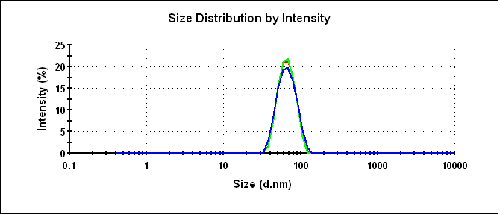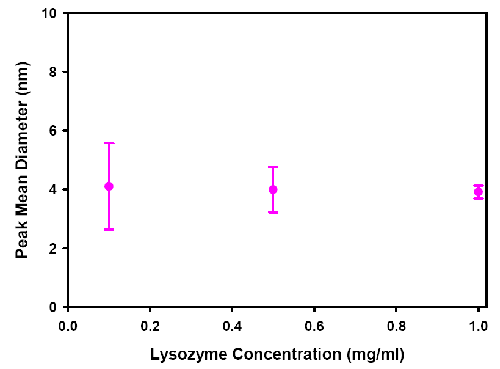For the Zetasizer Nano S or ZS instrument, the minimum concentration specification for size measurements is 0.1ppm of a 60nm NIST traceable polystyrene latex and 0.1mg/mL of a lysozyme solution. This technical note contains details of the experimental procedures and results obtained from measurements of a NIST traceable 60nm polystyrene latex standard and from a 0.1mg/mL lysozyme solution as demonstration of these minimum concentration limits.
The 60nm polystyrene latex standard was prepared in 10mM NaCl at a concentration of 0.1ppm
The lysozyme was prepared in 100mM KCl with 10mM BisTri solution at a concentration of 0.1mg/mL. The solution was filtered through the Whatman Anatop 20nm pore size filter and the concentration of the protein verified by measuring the absorbance at 280nm on a UV/Vis spectrophotometer. The concentration was determined using an extinction coefficient of 26.4 m2/mol at a wavelength of 280nm.
All measurements were taken at 25°C.
Table 1 summarizes the results obtained from three repeat measurements of a 0.1ppm concentration of a 60nm polystyrene latex in 10mM NaCl. The table shows the z-average diameter (in nanometers) and the polydispersity index values for each measurement, together with the mean and standard deviation values. The intensity particle size distributions obtained from the measurements are shown in figure 1.
| Run | z-Average Diameter (nm) | Polydispersity Index |
|---|---|---|
1 | 63.9
| 0.025 |
2 | 63.6 | 0.034 |
3 | 63.6 | 0.047 |
Mean (SD) | 63.7 (0.01) | 0.035 (0.01) |
The z-average diameters and polydispersity index values are all within specification and the repeatability of the values gives confidence in the results obtained.
Figure 2 is a plot of the mean size of peak 1 from the intensity particle size distributions obtained from measurements of lysozyme as a function of protein concentration. Each point shows an error bar which is one standard deviation of a set of 5 repeat measurements. At 0.1mg/mL the error in the measurement of size is larger than at higher concentrations but the mean value is in the expected size range for lysozyme.
At 0.1mg/mL, the cumulants analysis or z-average size is unsuitable as the baseline noise affects the mean size calculated, and this is better described using the largest peak from the protein distribution analysis.

|

|
The results reported in this technical note confirm that the minimum concentration limit for size measurements with the Zetasizer Nano S and ZS is 0.1ppm and 0.1mg/mL lysozyme.